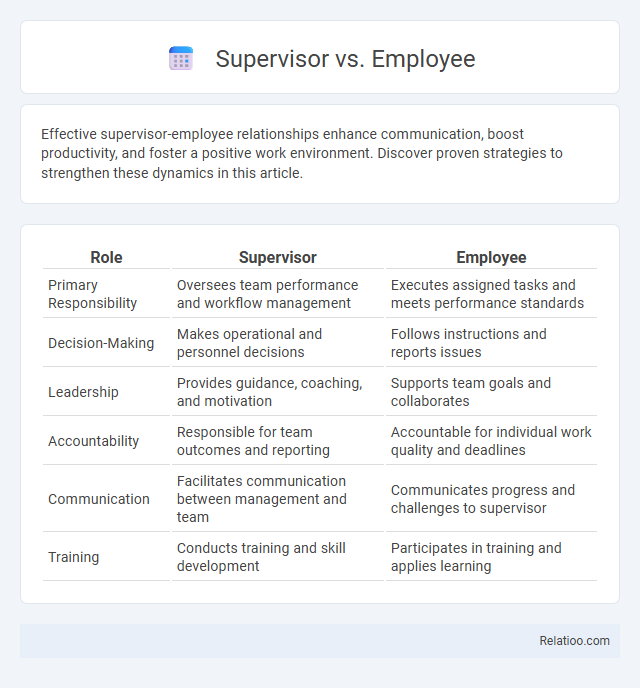Effective supervisor-employee relationships enhance communication, boost productivity, and foster a positive work environment. Discover proven strategies to strengthen these dynamics in this article.
Table of Comparison
| Role | Supervisor | Employee |
|---|---|---|
| Primary Responsibility | Oversees team performance and workflow management | Executes assigned tasks and meets performance standards |
| Decision-Making | Makes operational and personnel decisions | Follows instructions and reports issues |
| Leadership | Provides guidance, coaching, and motivation | Supports team goals and collaborates |
| Accountability | Responsible for team outcomes and reporting | Accountable for individual work quality and deadlines |
| Communication | Facilitates communication between management and team | Communicates progress and challenges to supervisor |
| Training | Conducts training and skill development | Participates in training and applies learning |
Understanding the Supervisor-Employee Relationship
Understanding the supervisor-employee relationship is essential in preventing harassment and fostering a respectful workplace environment. Supervisors hold significant authority, which requires them to exercise fair and ethical behavior to protect employees from discrimination and harassment. Your awareness of power dynamics and clear communication can ensure a safe, supportive work culture where rights and responsibilities are understood and respected.
Key Roles and Responsibilities
Supervisors are responsible for creating a safe and respectful work environment by enforcing anti-harassment policies and promptly addressing complaints, ensuring compliance with legal standards such as Title VII of the Civil Rights Act. Employees must understand their rights and responsibilities, reporting any harassment incidents while maintaining professionalism. Both parties play crucial roles in preventing harassment, fostering open communication, and participating in training programs designed to identify and mitigate workplace misconduct.
Authority and Decision-Making Power
Supervisors hold authority and decision-making power that directly impact employees' work conditions, task assignments, and disciplinary actions. This imbalance of power can create a vulnerable environment where harassment may occur if authority is misused or abused. Effective organizational policies and clear reporting mechanisms are essential to prevent harassment and protect employees within this power dynamic.
Communication Styles and Channels
Supervisors often use formal communication channels such as emails, meetings, and performance reviews to regulate workplace behavior, while employees may rely on informal or direct communication styles like face-to-face conversations or instant messaging. Effective communication styles are critical in preventing harassment, emphasizing clear, respectful, and assertive dialogue that addresses concerns promptly without ambiguity. Misalignment in communication channels between supervisors and employees can lead to misunderstandings, underscoring the need for organizations to establish transparent protocols to facilitate reporting and resolution of harassment incidents.
Performance Evaluation and Feedback
Performance evaluations conducted by supervisors play a crucial role in shaping employee development and workplace dynamics. Effective feedback from supervisors must be clear, objective, and focused on job-related criteria to prevent perceptions of harassment or bias. Establishing transparent performance standards and open communication channels helps maintain a respectful environment and reduces conflicts linked to performance appraisals.
Conflict Resolution Approaches
Effective conflict resolution between supervisors and employees in harassment cases involves clear communication protocols, unbiased investigation processes, and structured mediation sessions to address complaints promptly. Implementing employee training on harassment recognition and reporting, combined with supervisors' accountability measures, facilitates a respectful workplace culture. Utilizing third-party conflict resolution experts and establishing formal grievance procedures further ensures fair outcomes and reduces legal risks.
Career Growth and Advancement Opportunities
Supervisor behavior significantly impacts your career growth and advancement opportunities, as supportive leadership fosters skill development and promotions. Employees facing harassment by supervisors often experience stalled career progression due to a toxic work environment and diminished motivation. Addressing harassment effectively ensures a fair workplace where your professional development remains a priority, enabling sustained career advancement.
Training and Development Roles
Effective training and development programs play a critical role in defining the responsibilities of supervisors and employees in preventing workplace harassment. Supervisors must be trained to recognize, address, and report harassment incidents promptly while fostering a safe and inclusive environment. Employees require education on their rights and the procedures for reporting harassment, ensuring a clear understanding of acceptable workplace behavior and available support resources.
Impact on Workplace Culture
Supervisor harassment creates a toxic workplace culture by fostering fear and mistrust among employees, severely damaging team morale and productivity. Employee harassment incidents, whether peer-to-peer or from supervisors, undermine collaboration and increase turnover rates, costing organizations financially and reputationally. Your ability to address and prevent harassment is crucial for maintaining a respectful and inclusive work environment where all employees feel safe and valued.
Tips for Effective Supervisor-Employee Collaboration
Clear communication and established expectations foster trust between supervisors and employees, reducing misunderstandings that could lead to harassment claims. Regular training on workplace behavior and harassment prevention equips both parties with the knowledge to recognize and address inappropriate conduct promptly. Encouraging open dialogue and providing confidential reporting channels create a safe environment, promoting collaboration and minimizing conflicts related to harassment issues.

Infographic: Supervisor vs Employee
 relatioo.com
relatioo.com